
Wine Culture and Information since 2002 - Volume 22
 Wine Culture and Information since 2002 - Volume 22 |
|
Contrasts of Cortona Syrah and Primitivo di ManduriaA grape considered allochthonous and widespread throughout the Italian territory, in comparison with one of the best known varieties in Italy. A meeting in the glasses between Tuscany and Apulia. |
|
The importance and spreading of non-native varieties – also known as “international” – concern all wine-growing countries in the world and, of course, Italy is no exception. Cultivated and now well rooted in every region of Italy, the allochthonous grapes – in most of the cases, of French origin – have reached such an importance that they are used in many appellation wines of every Italian region. Their spreading is such that by now they have even become representative in many territories of Italy, often creating a solid and important bond such to be directly associated with these territories. The examples that could be given in this sense are many and are practically about all the international varieties that every wine lover knows or has tasted at least once. This is what also happened with Syrah – primary red berried grape of the Rhône Valley, in France – and which today represents a fundamental variety and intimately associated with Cortona denomination, in Tuscany. If it is true that in Italy the presence of the so-called international grapes is important and significant, this certainly does not mean that the native grapes of the country are somehow penalized or less important. All too evident, Italy's greatest and most prestigious enological interpretations – and for which it is famous all over the world – are mainly produced with native grapes. This is certainly true for every region of Italy and – of course – Apulia and its very important Primitivo variety are no exception. Although the origin of this grape is not exactly Apulia – today we know it was introduced from Dalmatia – Primitivo has created an indissoluble bond with this region and it is right here it expresses itself in an extraordinary way. In this regard, it should be noted that although this grape is found throughout Apulia, Primitivo is however strongly and particularly linked with the territory of Manduria – in the province of Taranto – and in which the most representative wines of the region from this variety are produced.
|
|
Syrah is the dominant red grape variety of the Rhône Valley, France, and its wines undeniably are the primary reference for this grape. Although it is widespread in this territory, its origin is still uncertain today. Some genetic researches carried out on this grape have however been able to determine it is a cross between Dureza – a red grape variety from the Ardèche region, in France – and Mondeuse Blanche, typical of Savoy. As for the name, it should be noted that Syrah is the one by which it is known in France, generally in Europe and around the world, while in Australia – as well as in other parts of the world – it is known as Shiraz. It should also be noted that, in the past, this variety was also called “Hermitage”, the name of the famous French AOC of the Rhône valley and which red wines are among the best known and most important Syrah references worldwide. The wines of Hermitage AOC were in fact the main responsible in determining the international success of Syrah, a model that – unequivocally – has been pursued and sought after by practically all Syrah producers in the world. Syrah arrives in the territory of Cortona – in the province of Arezzo, in Tuscany – at the end of the 1960s and today it represents one of the most cultivated varieties of the vineyards in this appellation. A story of undeniable success and which required years of experimentation and study – in particular, those of prof. Attilio Scienza and the University of Milan – which have made it possible to create a quality enology model and based on Syrah. Thanks to these studies and researches, Cortona is today considered as the main reference territory for Syrah in Italy, reaching the recognition of Denominazione d'Origine Controllata (Denomination of Controlled Origin, DOC) in 2009. Syrah arrives in Tuscany in the early 1900s, probably introduced by the Count of Montecarlo of Lucca after a journey to France, then – after a few decades – it reaches Cortona. The interest for this variety in this area favored the study and experimentation of different clones with the aim of identifying the one that best suited the Cortona area, according to the local weather and soil conditions. The results were extremely positive and encouraging, so much that it has become – today – the most cultivated red berried variety in the territory of Cortona and to be considered the main Italian reference area for this variety.
|
||||
|
Primitivo is unequivocally associated to the viticulture of Apulia, however it is – so to speak – a variety which origins are far from this region, also reaching the west coast of the United States of America. When it comes to Primitivo, the association with Manduria, in the province of Taranto, and Gioia del Colle, in the province of Bari, is inevitable. Talking about Primitivo, not least, also means referring to an important red berried variety of California and which, for years, was considered to be indigenous to this territory: Zinfandel. In reality, Primitivo is neither Apulian nor Californian, but Croatian, more specifically, originally from Dalmatia. Genetic research carried out on this variety has in fact made it possible to establish that it actually is Crljenak Kaštelanski, a red grape from Dalmatia, still cultivated in this area for the production of red wines. The presence of Primitivo in Apulia dates back to the second half of the 1700s, probably introduced in these lands by the Illyrians, a population of the Balkan region and notoriously committed to viticulture. The first written records about Primitivo – although today it owes its fame to the wines of Manduria – lead to Gioia del Colle, in the province of Bari, a territory recognized as Denominazione d'Origine Controllata (Denomination of Controlled Origin, DOC) and which also provides for the use of Primitivo grape. This important variety takes its Italian name – Primitivo – from its characteristic of ripening in advance of the other red berried grapes of Apulia, being ready for harvesting as early as August. For this reason, it was initially called Primaticcio or Primative – from the Latin primativus, meaning “precocious” – hence Primitivo. In this regard, it should be noted this variety was initially known by the name Zagarese, still in use today in Apulia. In the territory of Manduria Primitivo produces wines of particular finesse and body, used both for the production of dry table wines and sweet wines from dried grapes. A grape with an important coloring power and capable of giving its wines remarkable personality and structure, Primitivo di Manduria is in most cases aged in cask, a technique giving wines a pleasing roundness capable of balancing, associated to alcohol, the appreciable astringency of tannins.
|
Before pouring the wines of our tasting by contrast into their respective glasses, we will search for the two bottles that we are going to examine. As opposed to the usual way of selecting wines and which we usually suggest – in particular, vinification carried out in inert containers – in this specific case our choice will be in favor of wines aged in cask. The reason for this choice is mainly due to what is usually done by the producers of these two wines, as in most cases, both Cortona Syrah and Primitivo di Manduria are aged in cask. In this regard, it should be noted that, according to the respective production disciplinary, this practice is not mandatory and aging in wood is required only for the Riserva styles. However, also in consideration of the specific qualities of Syrah and Primitivo grapes, producers generally prefer aging them in cask and, last but not least, in barrique. As for the composition, although their disciplinary provide for the use of the respective varieties for a minimum of 85%, we will make sure the two wines are exclusively produced with Syrah and Primitivo, both belonging to the most recent vintage and in any case not over three years. The wines are served in tasting glasses at a temperature of 18 °C. (65 °F) We can now start this month's tasting by contrast and – as usual – we will begin with the evaluation of the appearance, that is, how the wine is presented to the eye in terms of color and transparency. The first wine we will examine is Cortona Syrah. Let's tilt the glass over a white surface – a sheet of paper is enough – and let's observe the base of the glass, at the point of greatest thickness of the liquid mass. The wine shows an intense and brilliant ruby red color, while transparency – evaluated by placing an object between the glass and the white surface – is rather low. The nuance of Cortona Syrah, observed at the edge of the glass, towards the opening, at the point where the liquid mass is thinnest, reveals and confirms a ruby red color. Let's now pass to the evaluation of the aspect of Primitivo di Manduria and, as for the previous wine, let's tilt the glass over the white surface. The color of the Apulian wine is deep and intense ruby red; its transparency – as for the previous wine – is decidedly low. The nuance of the wine reveals a ruby red color, sometimes tending to garnet. The olfactory profiles of wines produced with Syrah and Primitivo are decidedly distant, although it is possible to perceive common aromas. In both cases, they are represented by dark-fleshed fruits, expressed with completely distinct intensity and quality. Syrah and Primitivo sometimes share some sensations typical to the world of flowers, always expressed with distinct intensity and quality. In wines produced with Syrah – as for the sensations belonging to the world of fruits – we can generally perceive aromas of black cherry, plum and black currant, often combined with blueberry. As already mentioned, in the wines produced with this grape can also be perceived sensations reminiscent of floral scents, generally expressed by violet and, sometimes, peony and lavender. Syrah is also famous for the typical spicy sensation in which can be recognized black pepper, notoriously produced by the rotundone sesquiterpene. Wines produced with Primitivo generally express decidedly more “mature” fruity sensations, in which we recognize plum, black cherry and blackberry, often raspberry and blueberry. The world of Primitivo flowers is mainly expressed by violet, last but not least, also withered. Let's resume our tasting by contrast and proceed with the evaluation of the olfactory profiles of Cortona Syrah and Primitivo di Manduria, starting with the examination of the Tuscan wine. Let's hold the glass in vertical position and, without swirling, let's proceed with the first smell in order to evaluate the opening of the wine, that is its identifying aromas and also defined as “first nose”. From the glass emerge intense, clean and pleasing aromas of black cherry, plum and black currant, followed by the scent of violet. Now let's swirl the glass – an operation favoring the oxygenation of the wine, therefore the development of the remaining aromas – and let's proceed with the second smell. The olfactory profile of Cortona Syrah is completed with blueberry, raspberry and pomegranate, often followed by peony. In addition to the aromas given by the aging in wood, it can also be perceived the unmistakable aroma of black pepper. Let's now pass to the evaluation of the olfactory profile of Primitivo di Manduria and proceed with the examination of its opening. From the glass we perceive clean, intense and pleasing aromas of plum, black cherry and blackberry, with a more mature character than Cortona Syrah. Moreover, we can perceive the pleasing scent of violet, sometimes withered. After having swirled the glass, the olfactory profile of Primitivo di Manduria is completed with blueberry and raspberry, to which often follows strawberry. Also in this case, the olfactory profile is characterized by the typical tertiary aromas given by the aging in wood. The organoleptic qualities of Cortona Syrah and Primitivo di Manduria continue to express substantial differences also during the analysis of their respective gustatory profiles. The first wine of which we will examine taste is, just like in the previous phases, Cortona Syrah. Let's take a sip of the Tuscan wine in order to appreciate its attack, that is, the primary and identifying gustatory qualities perceptible in the mouth. Cortona Syrah has an attack expressing a proper astringency – the tannins are well perceptible – promptly balanced both by the effect of alcohol and the aging in wood, factors producing a proper roundness. In the mouth are perceived flavors of black cherry, plum and black currant, therefore expressing a good correspondence to the nose. Let's now pass to the evaluation of the attack of Primitivo di Manduria and, then, let's take a sip. In the mouth, the Apulian wine immediately expresses greater roundness than Cortona Syrah, with well perceptible astringency and perfectly balanced both by alcohol and by the effect of the aging in wood. In the mouth, moreover, we perceive the flavors of plum, black cherry and blackberry, also in this case expressing good correspondence to the nose. We are now going to examine the final phase of our tasting by contrast, in which we evaluate the final sensations the wines leave in the mouth after swallowing, in particular the taste-olfactory persistence. The finish of Cortona Syrah is persistent and in the mouth we continue to perceive both the effect of astringency and of roundness, in particular of alcohol, in addition to the pleasing flavors of black cherry, plum and black currant. The finish of Primitivo di Manduria is also persistent and, compared to the Tuscan wine, the perception of roundness is decidedly stronger, while continuing to perceive the appreciable astringency of tannins. Moreover, in the mouth we perceive the flavors of plum, black cherry and blackberry. Another significant aspect in these two wines is the contribution and effect of alcohol, much more powerful in Primitivo di Manduria. Cortona Syrah, on the other hand, leaves a slight sensation of crispness in the mouth and stronger than in the Apulian wine. Before concluding the tasting by contrast of this month, let's place the two glasses side by side and proceed with the last smell: the differences between the two wines are still evident and distant.
|
||||||||
Wines of the Month |
|
|
|
Score legend Prices are to be considered as indicative. Prices may vary according to the country or the shop where wines are bought |
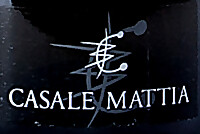
|
|
Frascati Spumante Brut |
|
| Casale Mattia (Latium, Italy) | |
 Malvasia di Candia, Malvasia Bianca, Trebbiano Giallo, Bombino, Bellone, Other Grapes Malvasia di Candia, Malvasia Bianca, Trebbiano Giallo, Bombino, Bellone, Other Grapes | |
| Price: € 12.00 | Score: |
 Brilliant greenish yellow and nuances of greenish yellow, very
transparent, fine and persistent perlage. Brilliant greenish yellow and nuances of greenish yellow, very
transparent, fine and persistent perlage.
 Intense, clean and pleasing, starts with hints of apple, plum and
citrus fruits followed by aromas of yeast, hawthorn, peach and pear. Intense, clean and pleasing, starts with hints of apple, plum and
citrus fruits followed by aromas of yeast, hawthorn, peach and pear.
 Effervescent and crisp attack, however balanced by alcohol, good body,
intense flavors, agreeable. Effervescent and crisp attack, however balanced by alcohol, good body,
intense flavors, agreeable.
 Persistent finish with flavors of apple, plum and peach. Persistent finish with flavors of apple, plum and peach. Produced with the Charmat method. Produced with the Charmat method. |
|
 Aperitifs, Vegetable and crustacean appetizers, Risotto with vegetables and crustaceans, Sauteed fish, Sauteed white meat, Eggs, Dairy products Aperitifs, Vegetable and crustacean appetizers, Risotto with vegetables and crustaceans, Sauteed fish, Sauteed white meat, Eggs, Dairy products |
|
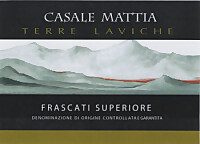
|
|
Frascati Superiore Terre Laviche 2020 |
|
| Casale Mattia (Latium, Italy) | |
 Malvasia di Candia, Malvasia Bianca, Trebbiano Giallo, Bombino, Bellone, Other Grapes Malvasia di Candia, Malvasia Bianca, Trebbiano Giallo, Bombino, Bellone, Other Grapes | |
| Price: € 8.50 | Score: |
 Intense greenish yellow and nuances of greenish yellow, very
transparent. Intense greenish yellow and nuances of greenish yellow, very
transparent.
 Intense, clean, pleasing and refined, starts with hints of apple, plum
and broom followed by aromas of hawthorn, broom, pineapple and pear. Intense, clean, pleasing and refined, starts with hints of apple, plum
and broom followed by aromas of hawthorn, broom, pineapple and pear.
 Crisp attack and however balanced by alcohol, good body, intense
flavors, agreeable. Crisp attack and however balanced by alcohol, good body, intense
flavors, agreeable.
 Persistent finish with flavors of apple, plum and pineapple. Persistent finish with flavors of apple, plum and pineapple. Aged in steel tanks. Aged in steel tanks. |
|
 Fish and vegetable appetizers, Risotto and pasta with fish and crustaceans, Sauteed white meat, Sauteed fish, Dairy products Fish and vegetable appetizers, Risotto and pasta with fish and crustaceans, Sauteed white meat, Sauteed fish, Dairy products |
|
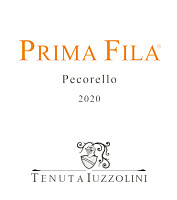
|
|
Prima Fila 2020 |
|
| Tenuta Iuzzolini (Calabria, Italy) | |
 Pecorello Pecorello | |
| Price: € 19.00 | Score: |
 Brilliant straw yellow and nuances of straw yellow, very transparent. Brilliant straw yellow and nuances of straw yellow, very transparent. Intense, clean, pleasing and refined, starts with hints of apple, peach
and banana followed by aromas of broom, hawthorn, pear, mango, plum,
hazelnut and vanilla. Intense, clean, pleasing and refined, starts with hints of apple, peach
and banana followed by aromas of broom, hawthorn, pear, mango, plum,
hazelnut and vanilla.
 Crisp attack and however balanced by alcohol, good body, intense
flavors, pleasing roundness. Crisp attack and however balanced by alcohol, good body, intense
flavors, pleasing roundness.
 Persistent finish with flavors of apple, peach and hazelnut. Persistent finish with flavors of apple, peach and hazelnut. 2 months in steel tanks, 2 months in barrique. 2 months in steel tanks, 2 months in barrique. |
|
 Pasta with fish, Stewed fish, Stewed white meat, Legume and mushroom soups, Cheese Pasta with fish, Stewed fish, Stewed white meat, Legume and mushroom soups, Cheese |
|
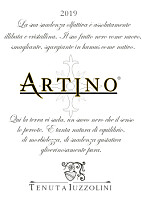
|
|
Artino 2019 |
|
| Tenuta Iuzzolini (Calabria, Italy) | |
 Gaglioppo (80%), Magliocco Canino (20%) Gaglioppo (80%), Magliocco Canino (20%) | |
| Price: € 19.00 | Score: |
 Intense ruby red and nuances of garnet red, little transparency. Intense ruby red and nuances of garnet red, little transparency. Intense, clean, pleasing, refined and elegant, starts with hints of
plum, black cherry and violet followed by aromas of raspberry, blueberry,
blackberry, tamarind, chocolate, tobacco, cardamom, mace, vanilla and
menthol. Intense, clean, pleasing, refined and elegant, starts with hints of
plum, black cherry and violet followed by aromas of raspberry, blueberry,
blackberry, tamarind, chocolate, tobacco, cardamom, mace, vanilla and
menthol.
 Properly tannic attack and however balanced by alcohol, good body,
intense flavors, agreeable. Properly tannic attack and however balanced by alcohol, good body,
intense flavors, agreeable.
 Persistent finish with flavors of plum, black cherry and raspberry. Persistent finish with flavors of plum, black cherry and raspberry. 6 months in barrique, 2 months in bottle. 6 months in barrique, 2 months in bottle. |
|
 Broiled meat and barbecue, Roasted meat, Stewed meat with mushrooms, Cheese Broiled meat and barbecue, Roasted meat, Stewed meat with mushrooms, Cheese |
|
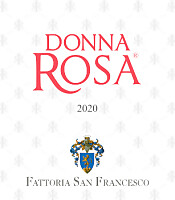
|
|
Donna Rosa 2020 |
|
| Fattoria San Francesco (Calabria, Italy) | |
 Gaglioppo Gaglioppo | |
| Price: € 15.00 | Score: |
 Intense cherry pink and nuances of cherry pink, transparent. Intense cherry pink and nuances of cherry pink, transparent. Intense, clean, pleasing and refined, starts with hints of cherry,
raspberry and blackberry followed by aromas of cyclamen, carnation,
strawberry, blueberry, peach and plum. Intense, clean, pleasing and refined, starts with hints of cherry,
raspberry and blackberry followed by aromas of cyclamen, carnation,
strawberry, blueberry, peach and plum.
 Crisp attack and however balanced by alcohol, good body, intense
flavors, pleasing roundness. Crisp attack and however balanced by alcohol, good body, intense
flavors, pleasing roundness.
 Persistent finish with flavors of cherry, raspberry and blackberry. Persistent finish with flavors of cherry, raspberry and blackberry. 4 months in barrique. 4 months in barrique. |
|
 Cold cuts, Pasta with fish, Roasted fish, Roasted white meat, Legume soups, Mushroom soups Cold cuts, Pasta with fish, Roasted fish, Roasted white meat, Legume soups, Mushroom soups |
|
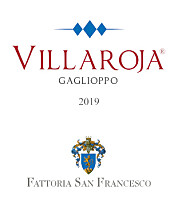
|
|
Villaroja 2019 |
|
| Fattoria San Francesco (Calabria, Italy) | |
 Gaglioppo Gaglioppo | |
| Price: € 15.00 | Score: |
 Intense ruby red and nuances of purple red, little transparency. Intense ruby red and nuances of purple red, little transparency. Intense, clean, pleasing and refined, starts with hints of plum, black
cherry and blackberry followed by aromas of violet, blueberry, raspberry,
carob, black pepper, vanilla and menthol. Intense, clean, pleasing and refined, starts with hints of plum, black
cherry and blackberry followed by aromas of violet, blueberry, raspberry,
carob, black pepper, vanilla and menthol.
 Properly tannic attack and however balanced by alcohol, good body,
intense flavors, agreeable. Properly tannic attack and however balanced by alcohol, good body,
intense flavors, agreeable.
 Persistent finish with flavors of plum, black cherry and blackberry. Persistent finish with flavors of plum, black cherry and blackberry. 5 months in steel tanks, 4 months in barrique. 5 months in steel tanks, 4 months in barrique. |
|
 Broiled meat, Roasted meat, Stewed meat with mushrooms, Hard cheese Broiled meat, Roasted meat, Stewed meat with mushrooms, Hard cheese |
|
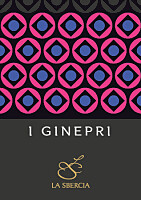
|
|
Oltrepo Pavese Cabernet Sauvignon I Ginepri 2019 |
|
| La Sbercia (Lombardy, Italy) | |
 Cabernet Sauvignon Cabernet Sauvignon | |
| Price: € 10.50 | Score: |
 Intense ruby red and nuances of ruby red, little transparency. Intense ruby red and nuances of ruby red, little transparency. Intense, clean, pleasing and refined, starts with hints of black
currant, black cherry and plum followed by aromas of violet, cyclamen,
blueberry, blackberry, raspberry, carob and bell pepper. Intense, clean, pleasing and refined, starts with hints of black
currant, black cherry and plum followed by aromas of violet, cyclamen,
blueberry, blackberry, raspberry, carob and bell pepper.
 Properly tannic attack and however balanced by alcohol, good body,
intense flavors, agreeable. Properly tannic attack and however balanced by alcohol, good body,
intense flavors, agreeable.
 Persistent finish with flavors of black currant, black cherry and plum. Persistent finish with flavors of black currant, black cherry and plum. Aged in steel tanks. Aged in steel tanks. |
|
 Broiled meat and barbecue, Roasted meat, Stewed meat with mushrooms, Cheese Broiled meat and barbecue, Roasted meat, Stewed meat with mushrooms, Cheese |
|
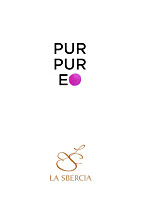
|
|
Purpureo 2018 |
|
| La Sbercia (Lombardy, Italy) | |
 Merlot Merlot | |
| Price: € 10.50 | Score: |
 Deep ruby red and nuances of ruby red, little transparency. Deep ruby red and nuances of ruby red, little transparency. Intense, clean, pleasing and refined, starts with hints of black
currant, black cherry and peony followed by aromas of violet, plum,
blueberry, raspberry, pomegranate and carob. Intense, clean, pleasing and refined, starts with hints of black
currant, black cherry and peony followed by aromas of violet, plum,
blueberry, raspberry, pomegranate and carob.
 Properly tannic attack and however balanced by alcohol, good body,
intense flavors, pleasing roundness. Properly tannic attack and however balanced by alcohol, good body,
intense flavors, pleasing roundness.
 Persistent finish with flavors of black currant, black cherry and plum. Persistent finish with flavors of black currant, black cherry and plum. Aged in steel tanks. Aged in steel tanks. |
|
 Pasta with meat, Broiled meat and barbecue, Stewed meat, Cheese Pasta with meat, Broiled meat and barbecue, Stewed meat, Cheese |
|
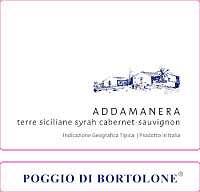
|
|
Addamanera 2020 |
|
| Poggio di Bortolone (Sicily, Italy) | |
 Syrah (70%), Cabernet Sauvignon (30%) Syrah (70%), Cabernet Sauvignon (30%) | |
| Price: € 10.50 | Score: |
 Brilliant ruby red and nuances of purple red, little transparency. Brilliant ruby red and nuances of purple red, little transparency. Intense, clean, pleasing and refined, starts with hints of black
cherry, black currant and blueberry followed by aromas of violet,
raspberry, plum and black pepper. Intense, clean, pleasing and refined, starts with hints of black
cherry, black currant and blueberry followed by aromas of violet,
raspberry, plum and black pepper.
 Properly tannic attack and however balanced by alcohol, good body,
intense flavors, agreeable. Properly tannic attack and however balanced by alcohol, good body,
intense flavors, agreeable.
 Persistent finish with flavors of black cherry, black currant and
blueberry. Persistent finish with flavors of black cherry, black currant and
blueberry.
 12 months in steel tanks, 4 months in bottle. 12 months in steel tanks, 4 months in bottle. |
|
 Stuffed pasta with meat and mushrooms, Roasted meat, Stewed meat with mushrooms Stuffed pasta with meat and mushrooms, Roasted meat, Stewed meat with mushrooms |
|
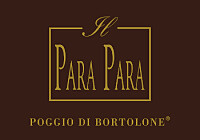
|
|
Cerasuolo di Vittoria Classico Il Para Para 2018 |
|
| Poggio di Bortolone (Sicily, Italy) | |
 Nero d'Avola (60%), Frappato (40%) Nero d'Avola (60%), Frappato (40%) | |
| Price: € 18.00 | Score: |
 Intense ruby red and nuances of garnet red, little transparency. Intense ruby red and nuances of garnet red, little transparency. Intense, clean, pleasing and refined, starts with hints of plum,
blackberry and dried violet followed by aromas of geranium, raspberry,
black cherry, strawberry, tobacco, carob, vanilla and menthol. Intense, clean, pleasing and refined, starts with hints of plum,
blackberry and dried violet followed by aromas of geranium, raspberry,
black cherry, strawberry, tobacco, carob, vanilla and menthol.
 Properly tannic attack and however balanced by alcohol, good body,
intense flavors, agreeable. Properly tannic attack and however balanced by alcohol, good body,
intense flavors, agreeable.
 Persistent finish with flavors of plum, black cherry and raspberry. Persistent finish with flavors of plum, black cherry and raspberry. 18 months in steel tanks, 10 months in cask, 6 months in bottle. 18 months in steel tanks, 10 months in cask, 6 months in bottle. |
|
 Broiled meat and barbecue, Roasted meat, Stewed meat, Cheese Broiled meat and barbecue, Roasted meat, Stewed meat, Cheese |
|
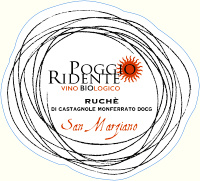
|
|
Ruchè di Castagnole Monferrato San Marziano 2020 |
|
| Poggio Ridente (Piedmont, Italy) | |
 Ruchè Ruchè | |
| Price: € 15.10 | Score: |
 Intense ruby red and nuances of ruby red, moderate transparency. Intense ruby red and nuances of ruby red, moderate transparency. Intense, clean, pleasing and refined, starts with hints of strawberry,
raspberry and rose followed by aromas of cyclamen, cherry, blueberry, plum,
pomegranate and black pepper. Intense, clean, pleasing and refined, starts with hints of strawberry,
raspberry and rose followed by aromas of cyclamen, cherry, blueberry, plum,
pomegranate and black pepper.
 Properly tannic attack and however balanced by alcohol, good body,
intense flavors, pleasing crispness. Properly tannic attack and however balanced by alcohol, good body,
intense flavors, pleasing crispness.
 Persistent finish with flavors of strawberry, raspberry and cherry. Persistent finish with flavors of strawberry, raspberry and cherry. Aged in steel tanks. Aged in steel tanks. |
|
 Cold cuts, Pasta with meat and mushrooms, Fish soups, Sauteed meat, Roasted white meat Cold cuts, Pasta with meat and mushrooms, Fish soups, Sauteed meat, Roasted white meat |
|
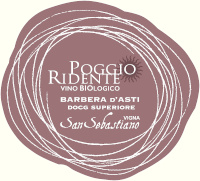
|
|
Barbera d'Asti Superiore San Sebastiano 2018 |
|
| Poggio Ridente (Piedmont, Italy) | |
 Barbera Barbera | |
| Price: € 13.70 | Score: |
 Intense ruby red and nuances of garnet red, little transparency. Intense ruby red and nuances of garnet red, little transparency. Intense, clean, pleasing, refined and elegant, starts with hints of
cherry, plum and violet followed by aromas of cyclamen, blueberry,
raspberry, blackberry, tobacco, chocolate, cinnamon, mace, vanilla and
menthol. Intense, clean, pleasing, refined and elegant, starts with hints of
cherry, plum and violet followed by aromas of cyclamen, blueberry,
raspberry, blackberry, tobacco, chocolate, cinnamon, mace, vanilla and
menthol.
 Properly tannic attack and however balanced by alcohol, good body,
intense flavors, pleasing crispness. Properly tannic attack and however balanced by alcohol, good body,
intense flavors, pleasing crispness.
 Persistent finish with flavors of cherry, plum and blueberry. Persistent finish with flavors of cherry, plum and blueberry. 12 months in barrique. 12 months in barrique. |
|
 Broiled meat and barbecue, Roasted meat, Stewed meat with mushrooms, Cheese Broiled meat and barbecue, Roasted meat, Stewed meat with mushrooms, Cheese |
|
|
||||||||
|
DiWineTaste Polls
|
| |||||||
Privacy Policy | |||||||


| Copyright © 2002-2024 Antonello Biancalana, DiWineTaste - All rights reserved |
| All rights reserved under international copyright conventions. No part of this publication and of this WEB site may be
reproduced or utilized in any form or by any means, electronic or mechanical, without permission in writing from DiWineTaste. |